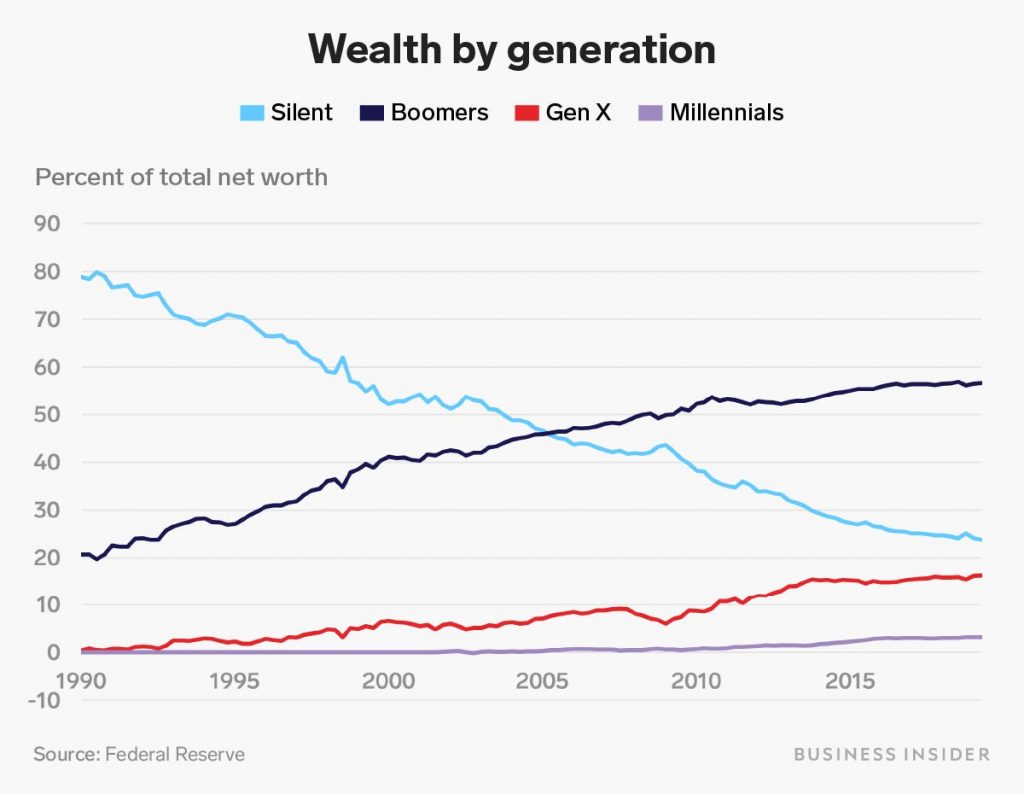Widespread adoption of and investment in cryptocurrencies has arguably been the asset classes’ number one pain point for years. While in many respects, things have come a long way, there’s still quite a bit of infrastructure that needs to be built in order to make widespread adoption and investment practical.
Earlier this week, Finance Magnates working to make crypto more accessible to a key group of investors that are often overlooked in the crypto world: GenXers and Baby Boomers, who together of the wealth in the United States.

The partnership, which will also include access to educational resources spanning blockchain and digital assets, aims to awareness and knowledge of blockchain and digital assets at a critical time for financial advisors–who, according to Galaxy and CAIS, are experiencing increased client demand for crypto-related products.
Recently, Finance Magnates sat down with Mike Novogratz and Matt Brown, founder and CEO of CAIS, to discuss the partnership and their hopes for how it could transform the cryptocurrency landscape.
This interview is an excerpt of a longer conversation with Matt Brown and Mike Novogratz. It has been edited for clarity and length.
The financial advisor space is crypto’s “big fat pitch”
Mike Novogratz and Matt Brown described the partnership between Galaxy Digital and CAIS as a marriage of mutual interests–to provide financial advisors with more information and access to cryptocurrencies and Bitcoin.
“We understood at Galaxy that we didn’t have a reach into the retail space,” Mike Novogratz explained, adding that Galaxy does invest in a number of wallets and exchanges that mostly deal with retail users. However, “looking at who’s going to adopt–and who needs to adopt–crypto next, and Bitcoin next, the financial advisor space is the ‘big fat pitch.’”
Indeed, Novogratz believes that it’s important to bring financial advisors into crypto because “the bulk of the wealth in America is held by 58-year-olds,” he continued. “It’s held by GenX and the baby boomers, not by millennials and GenZ.”

This is where “CAIS is perfectly aligned with [Galaxy Digital],” he continued. “They have a great educational platform, and their connectivity to this giant pool of financial advisors who will advise on most of the wealth of the country.”
Notably, in November 2019, Galaxy also created two Bitcoin-based funds named the Galaxy Bitcoin Fund and the Galaxy Institutional Bitcoin Fund–aimed toward “the wealth of America”–wealthy individuals between 50 and 80 years of age who may have been wary of investing in crypto in the past.
”The drumbeat around the [cryptocurrency and blockchain] space has been rising.”
Matt Brown explained that the journey towards the partnership began when “we got connected [with Galaxy] a little bit over a year ago.”
“[Galaxy’s] approach, the way they think about the infrastructure–the plumbing, the piping, the checks, the balances–really resonated with our approach,” he continued.
And the partnership was particularly timely: “over the years, the drumbeat around the [cryptocurrency and blockchain] space has been rising,” Matt Brown said.
“As a platform, we’ve always tried to be accommodating to the themes and products that our community wants to buy–to a very large degree, we have to be agnostic; we’re not telling them what to buy, we’re creating a market place where they can go and get what they want.”

CEO Matt Brown (middle) discusses the needs of Independent financial advisors with Sean Mullen of (left) and Matt Ackermann of @newsfromIN (right) – Summit 2017
— CAIS (@CAISgroup)
Therefore, “over the years, we went out and looked at [crypto market] players that might be similar to Galaxy, but unfortunately, all of them fell short of what we require on our platform, which is a real, true institutional-quality approach.”
Indeed, “[…] Bitcoin is still a pain in the ass to buy,” Mike Novogratz said. “Especially if you’re a 65-year-old retiree: it’s a lot easier to call your FA up and say, ‘I think you should have some of this Bitcoin’ or him to say, ‘hey, I think you should have some.’”
Mike Novogratz: ”It’s taken a lot longer for the institutions to get here than it thought it would”
Therefore, “putting this piping in–this plumbing in to make it easier is part of the evolution…of what Galaxy is doing, Novogratz said. “It’s a slower evolution than I would have wanted three years ago when I started this company, but it is happening.”
In February of this year, CoinDesk that Galaxy Digital laid off 13 people, roughly 15 percent of its workforce. At the time, a former employee told the publication that the reason for the layoffs was that Galaxy had hired people expecting the digital asset markets would develop more quickly than they actually did, and realized it had overbuilt.
Indeed, earlier in the conversation with Finance Magnates, Novogratz had remarked that “to be honest, it’s taken a ; maybe I was naive.”
However, Novogratz believes that systemic change seems to have suddenly begun to take off, particularly in the United States: “it feels like this year there’s been a big sea change: mostly driven by the fact that with corona, the policy response has been such crazy money printing–both in the US and abroad–that people are looking [for alternatives.]”
Crypto began as “a middle finger to the system”
He added that grassroots-driven systemic change is currently gripping the world on a number of levels: “you see systems change in the streets right now: people are protesting in the streets right now for racial justice systems change, and economic justice systems change–this really resonates with the core of the crypto community.”
We should remember that at its heart, the blockchain revolution is about systems change. And there are lots of strong teams working on it. Wishing the best and congratulating them on the progress.
— Michael Novogratz (@novogratz)
“Crypto started as the peoples’ revolution–It was a middle finger to the system,” he continued. “It was all about system change.”
This is particularly relevant at this current moment in time: “people are worried that the value of fiat money–their dollars and euros–is going to go way down because the government ”
“It makes a really strong case for Bitcoin as an asset with only .”
Crypto needs institutional investors and wealth managers to thrive
However, Novogratz believes that in the financial world, institutions must be included to make the “crypto revolution” really happen. However, he pointed out that this mission of systemic change that crypto was imbued with didn’t include larger financial institutions–at least, not at the beginning. “‘System change’, quite frankly, didn’t include JPMorgan; it didn’t include Fidelity. ‘Systems change’ [in this case was] to build a new monetary system outside of the traditional system.”
”Maybe because I’m old–though I identify as GenZ–I had this sense that in the long run, if you want to be part of the broader system…you need to bring in people that manage giant pools of capital, that are older; people whose [first instinct may not be] to check their Blockfolio account or Coinbase wallet,” Novogratz explained.
Proud of the team at and excited to partner with Bakkt
— Michael Novogratz (@novogratz)
This is why he : “Galaxy started with a mission to be a bridge between the crypto universe and the institutional world,” Novogratz began.
“This is a real moment for [wealth managers] to look at [crypto] as an asset class.”
Matt Brown pointed out a similar phenomenon: “the buyers of cryptocurrency right now tend to be the younger generation, and its more of a B2C play,” he said.
“Financial advisors are professionals who have the critical role of protecting and growing wealth for a huge swath of the US population–there’s about $20 trillion to $24 trillion dollars currently being managed by wealth management.”
“This is a real moment for that community to look at this as an asset class and really understand the best way to implement it as asset allocation.”
Brown added that there are four primary reasons that asset managers have not allocated in the cryptocurrency space: “access, education, due diligence, and execution”–but both Brown and Novogratz are hoping that their partnership will address each of those four pain points.
The inevitability of crypto
Therefore, when we asked whether or not it seems likely that 80 percent of institutional investors will have exposure to cryptocurrencies in their portfolios within the next five years, as earlier this week, Novogratz said yes.
“Besides Bitcoin becoming a proxy for gold, there’s a digital revolution going on, and payments are going to shift over, in time. There will be a ‘crypto dollar’, just like there’ll be a ‘crypto yuan’ and a ‘crypto euro’…I think every portfolio will have crypto in it.”
Citing conversations with institutional investors that he’s had with leaders of financial institutions in the US, Novogratz said that “[…] even the guys that aren’t in yet, they all realize that there’s an inevitability that we’re going to end up with a lot of crypto assets. It’s a question of when.”
“So, if you’re a big bank, you might miss the first three chapters, because there’s not enough money to be made, and get in for chapter four,” he added. Right now, “we’re on chapter two.”
“So, the reason that I think there’s a lot of upside is that I know there are nine chapters in the book coming after us.”
This interview is an excerpt of a longer conversation with Matt Brown and Mike Novogratz. It has been edited for clarity and length. Special thanks to Matt, Mike, and the teams at CAIS and Galaxy Digital.





Be First to Comment